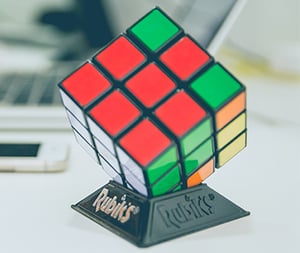Rubik's cube: patent, design or trademark?

Who hasn’t heard of the Rubik's cube? I used to spend many an hour struggling with it, but when it came to speed my brothers were generally a lot faster than me. I recently read an article which said that it was not possible to protect the cube, which first appeared on the market in 1974, with a trademark right. This seems rather illogical, so why was this trademark recently declared invalid?
Intellectual Property rights without patent
A British toy manufacturer registered the cube as a European trademark in 1999. This made it possible for them to continue the protection by means of Intellectual Property rights. It was no longer possible to apply for a patent on the cube. Mr Rubik, the creator of the product, once applied for a Hungarian patent himself. The twenty years that this was valid have long since passed.
That is why applying for a European trademark seemed like a smart move. Because:
- Under certain circumstances, a trademark is, in principle, valid for an indefinite period of time.
- You are allowed to register a trademark if you are already actively using it on the market. The novelty requirement is less strict than it is for patents.
Nature of an innovation
However, the European Trademark Office thought differently about this and rejected the trademark registration. In my opinion it was right to do so: the (external) design to be registered was too closely linked to the (technical) functionality of the cube. Determining the 'nature' of an innovation is a frequently recurring discussion.
The rule of thumb is:
- If the development is technically determined, you can protect it with a patent.
- If the development is unique because of its design, then design protection is possible.
- If the development is about identity, a trademark is a way of protecting the IP rights.
Protection via patent, design or trademark right?
The Rubik's cube was a borderline case, which has now been clarified. In practice I often see inventions that can be protected on the basis of technology as well as on the basis of design. Is it better to apply for a patent, or to protect the innovation via a design or a trademark in that case? The answer to that question is: "it all depends on your invention" - but you will probably find that answer rather unsatisfactory.
That is why if you have an invention that is on the borderline of different forms of protection, please contact us and we will be happy to help you.
And if you have any suggestions for how I could beat my brothers at solving the cube, please also let me know.

About the author
I studied mechanical engineering and materials science at Delft University. I joined EP&C as a trainee patent attorney in 2015 and qualified as a Dutch and European Patent Attorney in 2021. In...
More about Thomas >